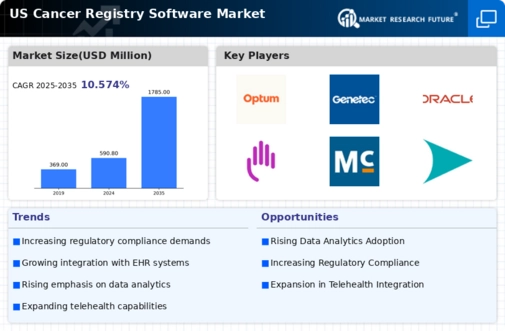The US Cancer Registry Software Market is characterized by a competitive landscape dominated by several key players that leverage advanced technologies to enhance cancer data management and reporting capabilities. As the healthcare industry continually scans for solutions to improve patient outcomes, the demand for efficient, robust, and user-friendly cancer registry software has risen significantly. This demand is underscored by the need to comply with regulatory mandates and to streamline the management of extensive patient and treatment data associated with cancer care.
Companies are focused on innovation and investment in research and development to provide comprehensive tools that assist healthcare institutions in tracking, analyzing, and reporting cancer incidences and treatment results effectively. The competition further intensifies as these firms not only compete on technological advancements but also on their ability to offer superior customer service and support.
Allscripts commands a significant presence in the US Cancer Registry Software Market by providing an integrated approach to healthcare management, which includes cancer registry capabilities. The strengths of Allscripts lie in its ability to deliver comprehensive electronic health record (EHR) systems that facilitate the collection and reporting of cancer data. Their cloud-based solutions enhance accessibility, allowing registered users to analyze data in real-time and improve patient care. Allscripts is known for its commitment to innovation, regularly updating its software to comply with regulatory requirements, which ensures that healthcare providers can effectively manage cancer registries.
The company's strong partnerships within the healthcare ecosystem further allow it to deploy solutions that are tailored to the specific needs of cancer care providers across various settings, thus solidifying its position in the market.
Optum, as a part of the UnitedHealth Group, has established a prominent foothold in the US Cancer Registry Software Market by integrating data analytics and technology solutions into its offerings. Known for its comprehensive healthcare services, Optum leverages its extensive resources to provide tools that assist healthcare professionals in the management of patient care and cancer registry operations. The strength of Optum lies in its ability to combine its cancer registry software with broader healthcare analytics capabilities, enabling organizations to derive insights from the data collected effectively.
The company is also recognized for its strategic mergers and acquisitions, which have bolstered its technology stack and expanded its service offerings in the realm of cancer treatment and management. Optum’s focus on enhancing interoperability and streamlining processes ensures that healthcare providers can improve their operational efficiency while focusing on patient outcomes and adherence to regulatory standards.























